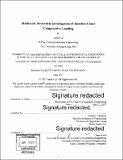| dc.contributor.advisor | Markus J. Buehler. | en_US |
| dc.contributor.author | Cui, Junhe | en_US |
| dc.contributor.other | Massachusetts Institute of Technology. Department of Civil and Environmental Engineering. | en_US |
| dc.date.accessioned | 2017-09-15T15:37:16Z | |
| dc.date.available | 2017-09-15T15:37:16Z | |
| dc.date.copyright | 2017 | en_US |
| dc.date.issued | 2017 | en_US |
| dc.identifier.uri | http://hdl.handle.net/1721.1/111508 | |
| dc.description | Thesis: M. Eng., Massachusetts Institute of Technology, Department of Civil and Environmental Engineering, 2017. | en_US |
| dc.description | Cataloged from PDF version of thesis. | en_US |
| dc.description | Includes bibliographical references (pages 66-70). | en_US |
| dc.description.abstract | Bamboo has been widely utilized as a load bearing material in building construction since ancient times by taking advantage of its excellent mechanical performance under loading as well as its low density and rapid growth. Application of bamboo to engineering, architecture and infrastructure requires in-depth understanding of the relationship between its morphology and mechanics, including how this regularly spaced segmental structure is optimized for its load bearing capability. However, our current knowledge about the linkage between the hierarchical structure and mechanical performance of bamboo is quite limited and we have little idea about the contribution of its regular spaced segment to its excellent mechanical behavior under various kinds of loading conditions. Here, we have implemented representative volume elements to our finite element analysis to study the mechanical response of the entire bamboo under compressive force and systematically investigated how the bamboo's meso-scale and macro-scale structural features (e.g., gradient fiber distribution, periodic nodes, etc.) contribute to its strength in compression. We find that column buckling is a critical failure mode that leads to overall collapse of the structure, which can be disastrous. We observe that the gradient fiber distribution pattern along the bamboo thickness direction significantly contributes to its strength. We find that the occurrence of fiber deviation at the node region reduces the strength of bamboo. Nevertheless, our results show that structural features such as external ridge and internal diaphragm play the role of reinforcement while the effect is more significant for bamboo than other plants with similar node appearance. The work reported in this thesis provides structural insights into the outstanding mechanics of bamboo, which could offer guidance for engineers to evaluate the material mechanics according to its structure and design high-performance structures with bamboo accordingly. | en_US |
| dc.description.statementofresponsibility | by Junhe Cui. | en_US |
| dc.format.extent | 70 pages | en_US |
| dc.language.iso | eng | en_US |
| dc.publisher | Massachusetts Institute of Technology | en_US |
| dc.rights | MIT theses are protected by copyright. They may be viewed, downloaded, or printed from this source but further reproduction or distribution in any format is prohibited without written permission. | en_US |
| dc.rights.uri | http://dspace.mit.edu/handle/1721.1/7582 | en_US |
| dc.subject | Civil and Environmental Engineering. | en_US |
| dc.title | Multiscale structural investigation of bamboo under compressive Loading | en_US |
| dc.type | Thesis | en_US |
| dc.description.degree | M. Eng. | en_US |
| dc.contributor.department | Massachusetts Institute of Technology. Department of Civil and Environmental Engineering | |
| dc.identifier.oclc | 1003324093 | en_US |
